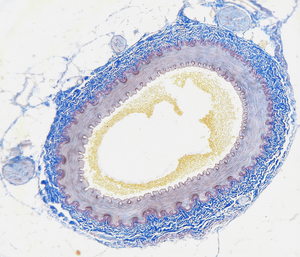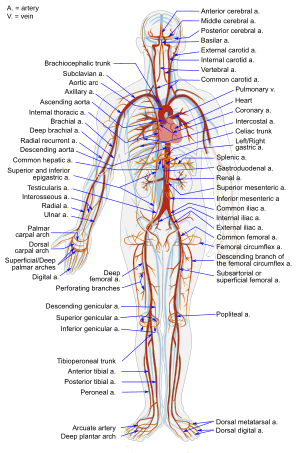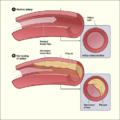Artery facts for kids
An artery is a special tube in your body that carries blood away from your heart. Think of it like a highway for blood! Most arteries carry blood that is full of oxygen. This oxygen-rich blood goes to all parts of your body, giving them the energy they need. The only arteries that don't carry oxygen-rich blood are the pulmonary artery and, in a baby before birth, the umbilical artery.
Every artery has three layers. The outside layer is a strong, stretchy covering. The middle layer is made of muscle. This muscle helps the artery get wider or smaller. This way, it can control how much blood flows to different parts of your body. The inside layer is smooth, just like the lining of your heart.
Arteries are usually found deep inside your body, under your skin. They don't have special flaps called valves to stop blood from flowing backward. Instead, when your heart beats, the arteries stretch out. This stretching makes room for the blood to move forward. After the blood passes, the muscles in the artery walls squeeze back. This squeezing action helps push the blood along.
Important Arteries in Your Body
The Aorta: Your Body's Main Blood Highway
The aorta is the biggest and most important artery in your body. It starts right from the left side of your heart. This part of the heart is full of blood that just got a lot of oxygen from your lungs. We call this "oxygenated" blood. Your heart then pumps this oxygen-rich blood into the aorta. From there, the aorta delivers this vital blood to every organ and part of your body.
The aorta travels all the way from your heart down to your lower belly. Along its path, smaller arteries branch off from it. These branches are like exits on a highway, leading blood to different areas. For example, some branches go to your arms, and others go to your head. The aorta finally splits into two main arteries that carry blood to your legs.
Almost every artery in your body is connected to the aorta, except for the pulmonary artery. Some other important arteries include:
- The carotid arteries, which send blood to your brain, head, and face.
- The femoral arteries, which carry blood to your legs.
- The coronary arteries, which supply blood directly to your heart muscle.
The Pulmonary Artery: A Special Case
The pulmonary artery is unique because it's the only artery in an adult body that:
- Is not connected to the aorta.
- Carries blood that doesn't have much oxygen. This is called "deoxygenated" blood.
After your body uses the oxygen from the blood, the blood becomes deoxygenated. This blood then travels through tiny vessels called capillaries. From the capillaries, it moves into veins. Veins are blood vessels that carry this deoxygenated blood back to the right side of your heart. The pulmonary artery then takes this blood from your heart to your lungs. In the lungs, the blood picks up fresh oxygen.
Once the blood is full of oxygen again, it goes back to the left side of your heart. Then, the aorta pumps it out to your body, and the cycle starts all over!
Problems That Can Affect Arteries
Arterial Bleeding: When Arteries Are Injured
Arteries are under a lot of pressure because your heart pumps blood directly into them. They are always stretching and squeezing to push blood forward. Because of this high pressure, bleeding from an artery can be very serious. This is called an "arterial bleed." It can happen very quickly. For example, if a large artery in your leg is cut, a person can lose a lot of blood fast.
If an artery in the brain starts to bleed, it can cause a stroke. A stroke happens when part of the brain doesn't get enough blood and oxygen.
Arteriosclerosis and Atherosclerosis: Stiff or Clogged Arteries
When someone has arteriosclerosis, the walls of their arteries become hard, stiff, and less stretchy. This makes it harder for blood and oxygen to reach important organs in the body.
One common type of arteriosclerosis is called atherosclerosis. This is a condition where arteries get narrower. They become clogged with fatty substances like cholesterol. Imagine a sink pipe getting clogged with grease; water struggles to get through. Similarly, clogs in arteries make it harder for blood to flow. This means your heart has to work much harder to push blood through. Atherosclerosis can lead to high blood pressure and other heart problems.
If atherosclerosis affects the coronary arteries (which feed your heart), it can cause coronary heart disease. If these arteries get too clogged, your heart muscle won't get enough blood and oxygen. This can lead to chest pain (called angina), a heart attack, or even serious heart failure.
When atherosclerosis happens in an artery leading to the brain, it can also cause a stroke.
Aneurysms: Bulges in Artery Walls
An aneurysm is like a small balloon-shaped bulge that forms on the wall of an artery. It fills with blood. As this bulge grows bigger, it becomes more likely to break open, or "rupture." If an aneurysm ruptures, the artery will start bleeding. If it's a large artery, a person can lose a lot of blood quickly. Also, if an artery is bleeding, blood can't flow past the rupture to the rest of the body. This means the body parts that artery is supposed to supply won't get the blood and oxygen they need. A ruptured aneurysm is a serious medical emergency.
See also
 In Spanish: Arteria para niños
In Spanish: Arteria para niños
Images for kids




